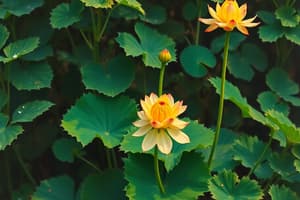Podcast
Questions and Answers
Match the following characteristics with the correct biological kingdom:
Match the following characteristics with the correct biological kingdom:
Multicellular, move with cilia or flagella = Animalia Acquire nutrients by absorption = Fungi Organelles including chloroplasts and cell walls = Plantae Mostly single-celled, may have chloroplasts = Protists
Match the following reproductive methods with the correct biological kingdom:
Match the following reproductive methods with the correct biological kingdom:
Asexual reproduction through binary fission = Protists Reproduce by means of spores or binary fission = Fungi Reproduce sexually by the fusion of gametes = Plantae Sexual reproduction observed rarely = Protists
Match the following plant habitat types with their descriptions:
Match the following plant habitat types with their descriptions:
Plants that live in moderate temperature = Mesophyll Plants that live in scarce water supply and dry conditions = Xerophytes Aquatic or water plants that live in extreme water conditions = Hydrophytes Plants that grow in salt or saline soils = Halophytes
Match the following branches of botany with their descriptions:
Match the following branches of botany with their descriptions:
Match the following organisms with their examples:
Match the following organisms with their examples:
Match the following characteristics with the correct kingdom:
Match the following characteristics with the correct kingdom:
Match the following kingdoms with their classification based on the presence of nuclei and membrane-bounded organelles:
Match the following kingdoms with their classification based on the presence of nuclei and membrane-bounded organelles:
Match the following kingdoms with their examples of organisms:
Match the following kingdoms with their examples of organisms:
Match the following characteristics with the correct kingdom based on size and DNA structure:
Match the following characteristics with the correct kingdom based on size and DNA structure:
Match the following kingdoms with their method of reproduction:
Match the following kingdoms with their method of reproduction:
What are the key characteristics of organisms in the kingdom Monera?
What are the key characteristics of organisms in the kingdom Monera?
How do organisms in the kingdom Monera obtain nutrients?
How do organisms in the kingdom Monera obtain nutrients?
What are the key characteristics of organisms in the kingdom Protista?
What are the key characteristics of organisms in the kingdom Protista?
What distinguishes Eukaryotic cells from Prokaryotic cells?
What distinguishes Eukaryotic cells from Prokaryotic cells?
What are the five kingdoms used to classify living organisms?
What are the five kingdoms used to classify living organisms?
What are the key differences between plant-like protists and animal-like protists?
What are the key differences between plant-like protists and animal-like protists?
How do fungi acquire nutrients, and what distinguishes them from plant-like protists and animal-like protists?
How do fungi acquire nutrients, and what distinguishes them from plant-like protists and animal-like protists?
Describe the reproductive methods of plant-like protists, fungi, and plants.
Describe the reproductive methods of plant-like protists, fungi, and plants.
What are the distinguishing characteristics of the Kingdom Animalia, and how do they acquire nutrients?
What are the distinguishing characteristics of the Kingdom Animalia, and how do they acquire nutrients?
Explain the differences between the branches of botany, Plant Morphology, and Plant Anatomy.
Explain the differences between the branches of botany, Plant Morphology, and Plant Anatomy.




